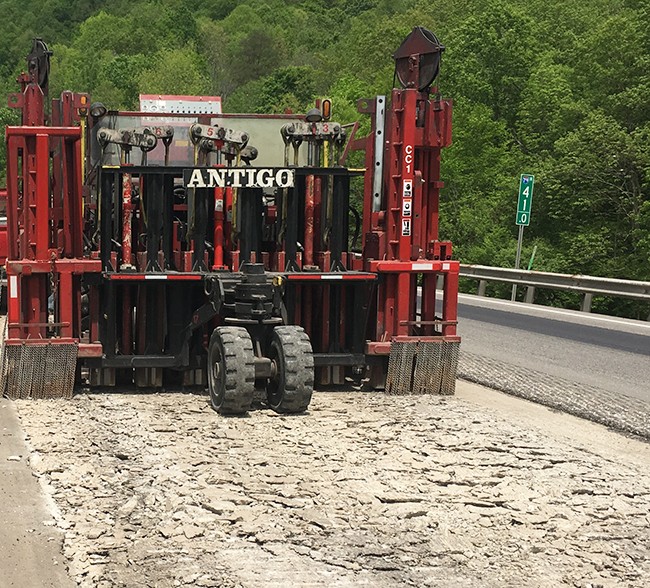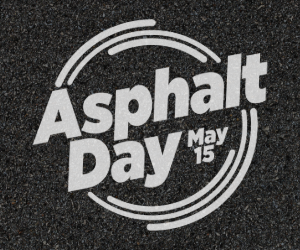
Highway agencies around the country face a challenge when trying to find a solution to address deteriorated concrete pavements. A few viable options are available for sound rehabilitation techniques that will result in asphalt pavements with excellent service life.
Removing the old concrete and replacing it with new portland cement concrete (PCC) pavement is an expensive option. Removing the concrete and constructing a new hot mix asphalt (HMA) pavement is normally less expensive, but it still incurs the cost of removing and wasting the old pavement. Overlaying the existing concrete with HMA is relatively inexpensive. However, with this option, reflective cracking can be a maintenance problem.
In states where there are a significant number of miles of deteriorated PCC pavements or PCC composite pavements, engineers need alternatives to these conventional strategies that are cost effective and have a proven track record of accomplishing a permanent fix. Many highway agencies are finding that rubblization of the deteriorated concrete and overlaying with HMA is the most effective treatment option.
Rubblization is the process of fracturing the worn-out concrete into small, typically 2- to 6-inch, pieces and converting it into an interlocked but flexible base material. The rubblizing process breaks the bonds between any reinforcing steel and the concrete, eliminates slab movement, and nearly eliminates the possibility of reflective cracking. The process includes “rubblizing” the concrete pavement, then compacting and solidifying the roadbed before resurfacing. This process will increase the lifespan of any overlay and ensure a better driving experience for the traveling public.
Travis Walbeck, former State Pavement Engineer for West Virginia Division of Highways (WVDOH), stated: “The decision was made to rehabilitate a large quantity of badly distressed composite pavements. Several methods of reconstruction were considered and after a careful analysis of all of the options, it was determined that rubblization of the existing concrete pavement was the most cost-effective option.”
History of rubblization in West Virginia
There is a long history of successful use of rubblization technology on the West Virginia Turnpike on I-64 and elsewhere in the state.
In June 1998, over 90 DOT staff from 15 states attended a rubblizing demonstration of a 16-year-old concrete pavement prior to placing a 10-inch thick HMA overlay on a section of I-77 / I-64 on the WV Turnpike.
West Virginia Turnpike officials gave a number of reasons for choosing rubblization as the best method of rehabilitation. Some of the factors that were considered were:
• A 10-mile section of the West Virginia Turnpike was rubblized in 1989 and overlaid with asphalt. Its performance has been outstanding.
• Total construction with PCC is out of the question because it is too expensive and time consuming.
• Delays with heavy traffic flow on the turnpike would be intolerable to the public.
• PCC slab repair and patching are expensive and time-consuming. Traffic flow is difficult during construction. PCC patches don’t address all of the distresses in the pavement.
• HMA overlays without rubblization will not prevent joints and cracks from reflecting through in a relatively short time.
• Rubblizing has proven far more cost-effective than any other PCC pavement rehabilitation method.
A limited rubblization program was carried out a few years after the turnpike project. These projects have not shown the same good performance as the fully rubblized sections. The practice was stopped for approximately ten years with no new rubblization of any kind.
In 2009 the WVDOH created a task force to improve pavement life throughout the state. One item born out of the task force was a nine-year warranty program that allowed contractors to choose the rehabilitation method and the pavement type. All eight of the warranty projects constructed to date have utilized rubblization with seven to nine inches of new HMA, depending on the traffic. The highway department learned from what the contractors depended on to ensure superior performance through the life of the warranty – rubblization. In 2015, a new WV specification was written and approved for the use of rubblization around the state.
Rubblization equipment and operation
There are two basic types of rubblization equipment and technology available in the United States: the resonant breaker manufactured by RMI and the multi-head breaker (MHB) manufactured by Antigo. Both rubblization technologies have been used successfully on many projects throughout the world.
On the WVDOH warranty projects, the contractors could select from both rubblization technologies and chose to use MHB equipment. In order to optimize the rubblization process, contractors worked closely with Antigo personnel to customize the equipment setup and operation for each particular project.
The MHB Badger Breaker® has sixteen drop hammers mounted laterally in pairs with half of the hammers in a forward row and the remainder diagonally offset in a rear row providing continuous breaking of up to thirteen feet wide. The hammers vary in weight from 1,200 to 2,000 pounds with the choice of hammers utilized based on the energy required to adequately fracture the particular concrete pavement. The drop height of each pair of hammers is independently adjustable to ensure the proper amount of breaking across the width of the machine. The travel speed of the MHB is adjusted to vary the spacing between hammer hits.
Matt Shinners of Antigo talked about factors that should be considered when setting up the MHB for a specific project: “The support provided by the subgrade and base significantly affects the particle sizing that is achievable. Generally, the better the support the smaller and more consistent the particles can be produced. The combination of hammer weights, drop heights and machine speed allow the MHB to perform the optimum rubblizing pattern for each particular combination of concrete pavement and subgrade/base support to meet the specification requirement for particle size.”
Drainage
The climate of West Virginia is classified as wet and cold. Draining stormwater away from the pavements is one of the keys to long term performance. Poor drainage often causes weak subgrade and support conditions that can inhibit the rubblization process. The installation of longitudinal edge drains prior to rubblization is recommended for all rubblization projects, unless a well-functioning drain system exists, or the subgrade consists of self-draining material such as sand. If trapped water beneath the slabs is not drained, it will interfere with the rubblization process.
Based on their past experience, WVDOH knew that installing edge drains as part of the rubblization process will not only remove water in the pavement and underlying materials initially which make it easier to rubblize but will continue to provide long-term drainage – improving performance. Ideally, the drainage system should be installed and functioning at least two weeks prior to the actual rubblization process so the subgrade can dry out. On the WVDOH projects, edge drains were installed well before the beginning of the rubblization process.
Construction
WVDOH Specifications for “Rubblization of Portland Cement Concrete Pavement” have the following requirements for either the resonant breaker or multi-head breaker rubblization technologies.
• Specification requirements for Resonant Breaker include: “The equipment will consist of a self-contained, self-propelled resonant frequency pavement breaking unit capable of producing low amplitude, 2,000 lbs. blows, at a rate of not less than 44 per second.”
• Specification requirements for Multi- Head Breaker were that the equipment must again be, “self-contained, self-propelled” and have the “capability of rubblizing pavement up to 13 feet in width, in a single pass.”
All of the pavements scheduled for rubblization were “composite” pavements meaning that they are existing concrete pavement with an asphalt overlay. The underlying concrete had varying thicknesses of asphalt overlays and even patches in some areas. Before rubblization could take place, the asphalt overlay had to be removed. In addition, WVDOH specifications stated that any patches larger than three square feet were to be removed from the PCC pavement.
The specifications state that the rubblization process shall consist of:
• At the surface, the equipment shall break the pavement such that 75 percent of the particles (by weight) are a maximum of two inches.
• Below the reinforcing steel or in the lower part of the concrete depth, 75 percent of the particles (by weight) are a maximum of nine inches.
• Concrete to steel bond will be broken. Remove reinforcing steel exposed at the surface but leave unexposed steel in place.
• Particle size should be verified with test pits at the beginning and at least one every mile throughout the project.
• Prior to placing the asphalt overlay, the complete width of the broken pavement shall be compacted by vibratory steel wheel and pneumatic tire rollers in the following sequence:
1.) After breaking, a minimum of four passes with a z-pattern steel grid roller, four additional passes with a standard vibratory roller and two passes with a pneumatic tire roller were required
2.) Just prior to the overlay, a minimum of two passes of the vibratory roller was required.
After rubblization and surface prep, Superpave asphalt overlays were placed in multiple lifts to a depth of typically nine inches.
2017 change order
During 2017, 20 lane miles of composite pavement on U.S. 119 were programmed to have the old HMA overlay removed and concrete pavement repaired and diamond ground. Once the concrete was exposed, it was easy to see that it could not withstand traffic, even after repairs. The contractor proposed using rubblization and a new HMA overlay to put the roadway back into service. This proposal was accepted and the DOH is happy with the performance and extended service life.
2018 and 2019 WVDOH projects
In an effort to use increased funding wisely, the WVDOH management tasked pavement staff with recommending projects that would last longer than the bonds but could be constructed quickly to show the public that their support was warranted. A list of projects around the state was developed using the state’s existing Pavement Management System. Subsequently, in the fall of 2017 the WVDOH awarded 12 reconstruction projects for composite pavements on the interstate system. These projects were intended to be constructed in 2018 and 2019 and totaled 60 centerline miles of roadway.
The 12 projects that were awarded in the fall of 2017 showed the citizens of West Virginia that their tax dollars were being spent on the road network that was in need of rehabilitation. Six of the projects required the contractor to use rubblization on the PCC pavement, the other six used the nine-year warranty specification. Contractors could select any rehabilitation method that they wanted to and all of them ended up deciding on the rubblization option.
Matt Shinner, vice president of Antigo Construction stated “Rubblization activity ticked up nicely in 2018 all because of one state’s program. The West Virginia DOT let twelve projects that will include 1.8 million square yards of rubblization to be performed in 2018 and 2019.”
For the 2019 construction season there are two more major rehabilitation projects planned for West Virginia, historically these projects have gone to contractors who choose to rubblize to achieve long term performance. Walbeck says, “I’m a proponent of balancing our program. We need rubblization style projects to address composite pavement that are a maintenance burden on our people. These reconstruction projects coupled with preservation of good pavements give us the balance to gain ground in our pavement condition statewide.”
Future of rubblization in WV
Through the monitoring of pavement conditions in West Virginia, the DOH has documented that the warranty pavements, using rubblization, are out-performing traditional full depth new construction pavements. The existing subgrade and the firm foundation that rubblized PCC provides is a big part of this increase in performance. This has given staff like Walbeck the data to show decision makers the benefit of fully rubblizing PCC.
The contractors in West Virginia have welcomed this process as well. When asked about this new wave of work in West Virginia, Chad Miller, the Quality Manager of JF Allen Construction said, “I’d like to see us rubblize the rest of the composite pavement around the state. This process is going to make our asphalt pavements last a lot longer.” The condition of the previous rubblization projects shows this.
With asphalt overlays on the typical West Virginia composite pavement only lasting approximately ten years, this change in philosophy has been needed. Continuing to only address the system with 1.5 to 2-inch mill and fill projects is not extending the life of the system. The data from the initial rubblization projects show that the extended performance will be worth the additional up-front cost. This is true not only for the next resurfacing cycle, but the maintenance crews who have been charged with fighting the reflective cracking and keeping the road acceptable between overlays.
Walbeck is a former State Pavement Engineer for WVDOH and is now Training Manager for the National Center for Asphalt Technology. Horan is an Asphalt Institute Senior Regional Engineer based in Virginia.














